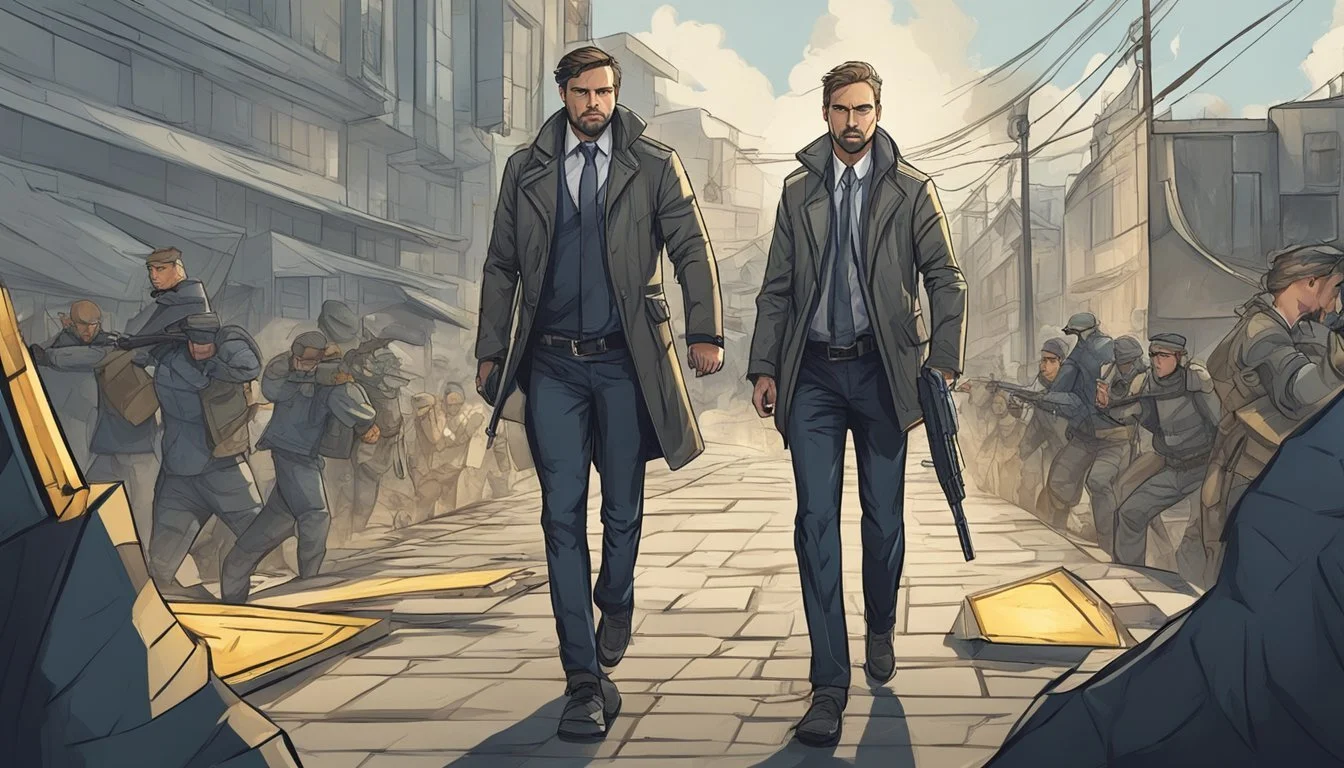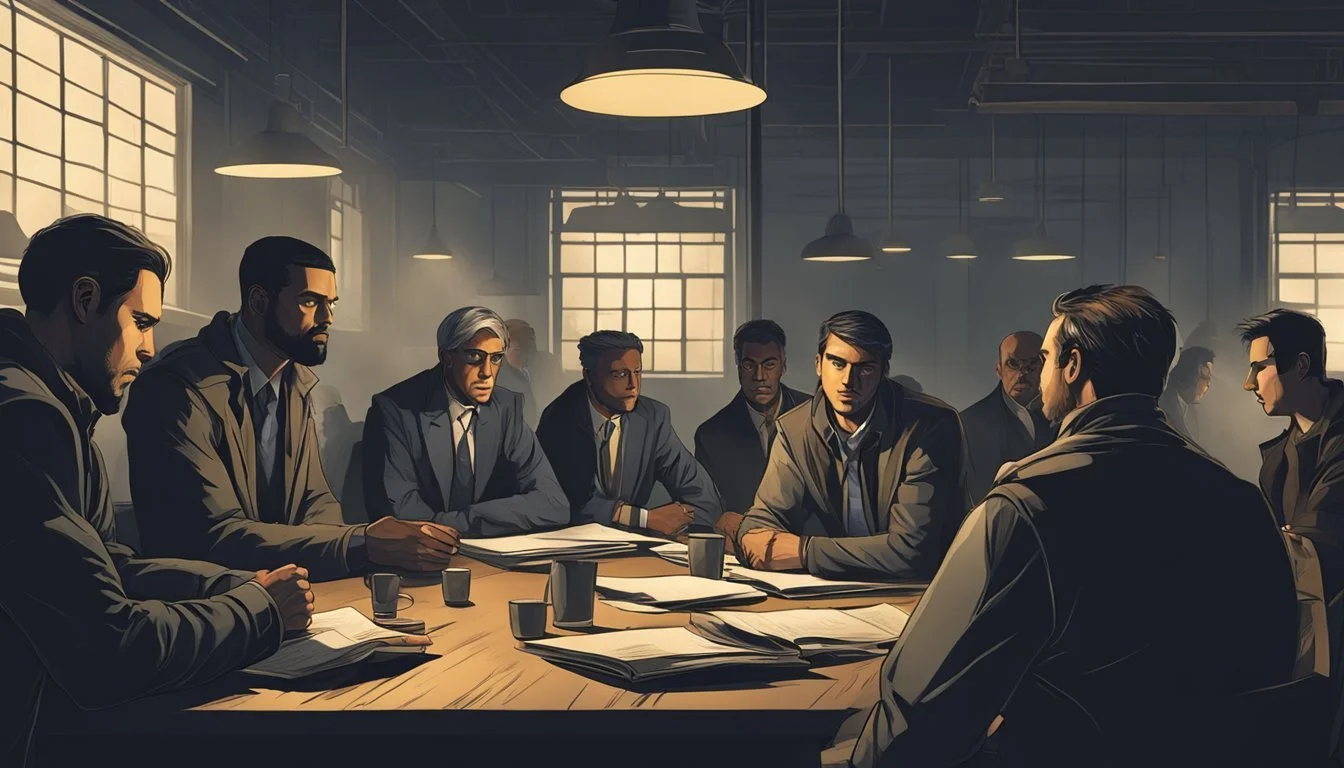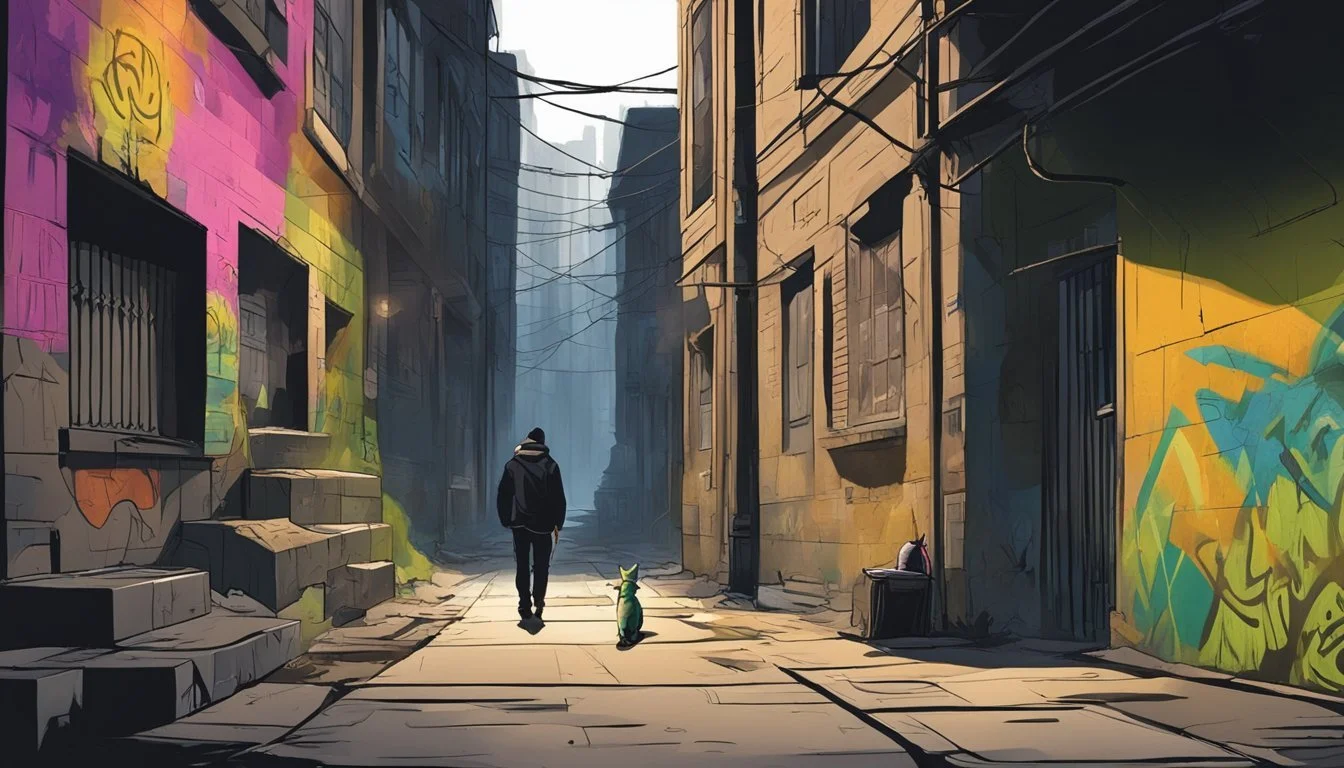The Importance of Loyalty in the Criminal Underworld of Breaking Bad
A Crucial Element for Survival and Success
Breaking Bad's criminal underworld is a treacherous landscape where loyalty serves as both a shield and a weapon. The series explores how characters navigate complex relationships built on trust, fear, and mutual benefit. In this dangerous realm, loyalty often determines survival, with betrayal carrying deadly consequences.
The show's protagonists and antagonists alike grapple with conflicting loyalties as they pursue power and profit. Walter White's descent into the drug trade tests his allegiance to family, while Jesse Pinkman struggles to reconcile personal loyalties with self-preservation. Criminal organizations like the Salamanca family demonstrate how blood ties can be a source of strength and vulnerability.
Key figures such as Mike Ehrmantraut embody the complexities of loyalty in this world. His unwavering commitment to certain principles and individuals stands in stark contrast to the shifting alliances around him. Through these characters, Breaking Bad illustrates how loyalty shapes the criminal underworld's power dynamics and ultimate fates.
Exploring the Theme of Loyalty
Loyalty forms a central pillar in Breaking Bad's criminal underworld. Characters grapple with conflicting allegiances, testing the limits of trust and commitment in a high-stakes environment.
The Moral Complexities of Loyalty
In Breaking Bad, loyalty is not a black-and-white concept. Characters face difficult choices between personal gain and remaining faithful to their associates. Walter White's transformation challenges his loyalty to his family and former self.
His actions often blur the line between protecting loved ones and serving his own interests. Jesse Pinkman's loyalty to Walt evolves throughout the series, shifting from admiration to resentment.
The show explores how loyalty can be both a virtue and a vice in the criminal world. Characters must decide when to stand by their allies and when to prioritize self-preservation.
Loyalty vs. Betrayal in Relationships
Breaking Bad showcases the tension between loyalty and betrayal in various relationships. The bond between Walt and Jesse is repeatedly tested by lies, manipulation, and conflicting agendas.
Family ties are strained as Walt's criminal activities threaten to tear his household apart. Skyler White's loyalty to her husband is pushed to its limits as she becomes complicit in his crimes.
In the cartel, loyalty is often enforced through fear and violence. Characters like Gus Fring demand unwavering allegiance from their subordinates, creating an atmosphere of constant suspicion.
The Consequences of Loyalty
Loyalty in Breaking Bad often comes at a steep price. Characters who remain loyal to their criminal associates find themselves drawn deeper into a world of violence and moral corruption.
Jesse's loyalty to Walt leads him down a path of guilt and self-destruction. Hank Schrader's commitment to justice and the law ultimately puts him in grave danger.
The show demonstrates how blind loyalty can be exploited by manipulative individuals. Walt's ability to command loyalty becomes a powerful tool in his rise to power, but also contributes to his eventual downfall.
Character Deep Dive
Breaking Bad's characters undergo profound transformations, grappling with loyalty, morality, and the consequences of their choices in the criminal underworld. Their complex arcs reveal the human struggles behind their criminal facades.
Walter White's Transformation
Walter White begins as a mild-mannered chemistry teacher but evolves into the ruthless drug kingpin Heisenberg. His initial motivation to provide for his family after a cancer diagnosis quickly gives way to a thirst for power and recognition.
Walt's moral decay accelerates as he embraces his criminal alter ego. He manipulates those around him, including Jesse, to maintain control. His actions become increasingly brutal, from poisoning a child to orchestrating prison murders.
This transformation strains Walt's relationships, especially with his wife Skyler and brother-in-law Hank. By the series end, he's isolated but unapologetic about his choices, fully embodying the Heisenberg persona he created.
Jesse Pinkman and the Quest for Redemption
Jesse Pinkman starts as Walt's former student and small-time drug dealer. His journey is marked by attempts to break free from the criminal world and find redemption.
Despite his involvement in the meth trade, Jesse retains a moral compass. He struggles with guilt over deaths he's caused, particularly Jane's and Andrea's. This internal conflict drives his desire to escape the drug business.
Jesse's loyalty to Walt wavers as he recognizes Walt's manipulations. He forms bonds with Mike and Andrea, seeking stability and normalcy. His arc culminates in rejecting Walt's influence and striving for a new life, symbolizing hope amidst the series' darkness.
Gustavo Fring: Respect and Ruthlessness
Gus Fring presents a facade of respectability as a fast-food chain owner while running a vast meth empire. His character embodies the duality of public persona and criminal mastermind.
Fring's business acumen and attention to detail make him a formidable opponent. He values loyalty and professionalism, rewarding those who meet his standards. However, he's ruthless in eliminating threats, as seen in his calculated murder of the cartel.
Gus's vendetta against the Salamancas reveals a personal motivation behind his criminal empire. His meticulous planning and patient approach contrast sharply with Walt's impulsive actions, creating a compelling power struggle.
Mike Ehrmantraut: The Stoic Enforcer
Mike Ehrmantraut, a former cop turned hitman, brings a pragmatic approach to the criminal world. His experience and calm demeanor make him a valuable asset to both Gus and Walt at different times.
Mike's actions are driven by a strong sense of loyalty and a desire to provide for his granddaughter. He forms a mentor-like relationship with Jesse, recognizing his potential and attempting to guide him.
Despite his criminal activities, Mike adheres to a personal code of ethics. He values professionalism and efficiency, often cleaning up messes created by others' rash decisions. His tragic end highlights the unforgiving nature of the world he inhabits.
The World of Crime in Albuquerque
Albuquerque's criminal underworld revolves around the methamphetamine trade, with complex networks of production and distribution. The city's legal system struggles to contain the growing influence of drug empires and their kingpins.
The Methamphetamine Trade
Albuquerque's meth business thrives due to its location and socioeconomic factors. The city serves as a hub for production and distribution, with labs hidden in suburban homes and desert locations. High-quality methamphetamine, known for its distinctive blue color, dominates the market.
Chemistry expertise plays a crucial role in the trade. Former teachers and skilled professionals often become involved, using their knowledge to create purer products. This technical prowess leads to the rise of powerful drug lords who control vast distribution networks.
The meth trade impacts various aspects of Albuquerque's society. It fuels gang activity, increases violence, and strains law enforcement resources. Addicts and their families suffer the consequences, while the promise of quick money lures many into the dangerous world of drug trafficking.
Legality and the Drug Empire
Albuquerque's legal system faces significant challenges in combating the drug trade. Law enforcement agencies struggle to keep pace with the evolving tactics of drug empires. Corruption within the system further complicates efforts to dismantle these criminal organizations.
Drug kingpins employ sophisticated methods to evade detection and prosecution. They use shell companies, money laundering schemes, and intimidation to protect their operations. The legal gray areas surrounding certain chemicals and equipment used in meth production make it difficult for authorities to prevent the manufacture of the drug.
The battle between law enforcement and drug empires creates a constant state of tension in Albuquerque. Innocent civilians often find themselves caught in the crossfire, while the city's reputation suffers from its association with the meth trade. Despite ongoing efforts to curb the drug problem, the allure of profits and power continues to fuel the criminal underworld.
Family Dynamics and Collateral Damage
The criminal activities of Walter White had far-reaching consequences for his loved ones. Family relationships were strained to the breaking point as secrets, lies, and moral compromises piled up.
Skyler White: The Reluctant Accomplice
Skyler White's journey from oblivious housewife to complicit partner was fraught with tension. Initially shocked by Walt's criminal activities, she eventually became entangled in money laundering schemes.
Her attempts to protect the family led to difficult choices. Skyler's relationship with Walt deteriorated as she grappled with the reality of his transformation.
The strain took a toll on Skyler's mental health. She struggled with guilt, fear, and isolation as she tried to maintain a facade of normalcy.
The Schrader Household
Hank and Marie Schrader found themselves unwittingly drawn into Walt's web of deceit. Hank's pursuit of the elusive Heisenberg put him on a collision course with his brother-in-law.
Marie supported Hank through his recovery from a near-fatal shooting. Unaware of the true culprit, she accepted Walt's financial assistance for Hank's medical bills.
The revelation of Walt's true identity shattered the bonds between the White and Schrader families. Hank's obsession with bringing Walt to justice strained his marriage and career.
Innocent Bystanders
Walt's actions had devastating effects on those with no connection to his criminal empire. His son, Walt Jr., struggled to reconcile the loving father he knew with the dangerous criminal Heisenberg.
Baby Holly became a pawn in her parents' conflict. Her future was forever altered by the choices made before she could even speak.
Jesse Pinkman's family suffered collateral damage from his association with Walt. His parents' attempts to help him ultimately drove them further apart.
Moral Decay and Personal Struggles
Breaking Bad's characters grapple with ethical dilemmas and internal conflicts as they navigate the criminal underworld. Their choices lead to a gradual erosion of moral principles and deeply personal struggles.
The Price of Power
Walter White's transformation into Heisenberg comes at a steep cost to his humanity. As he climbs the criminal ladder, he sheds his ethical constraints, justifying increasingly ruthless actions.
His initial noble intentions of providing for his family mutate into a thirst for power and recognition. This shift manifests in cold-blooded murders and manipulative schemes.
Walt's moral decay accelerates as he embraces his Heisenberg persona. He poisons a child, watches Jane die, and orders prison assassinations - acts that would have been unthinkable to his former self.
Identity and Pride
Pride becomes a driving force behind many characters' actions, often leading to their downfall. Walt's ego prevents him from accepting help or walking away from the meth business when he has the chance.
Jesse struggles with his identity as the "bad guy" while yearning for redemption. His attempts to break free from this label are repeatedly thwarted by circumstances and his own choices.
Hank's pride as a DEA agent blinds him to Walt's criminal activities. His obsession with catching Heisenberg ultimately puts his life and career at risk.
Addiction and Consequence
Substance abuse plays a central role in the moral decay of several characters. Jesse's drug addiction exacerbates his poor decision-making and emotional instability.
Walt Jr. and Marie grapple with the fallout of their family members' choices. Their lives are upended by the secrets and lies surrounding them.
The consequences of addiction extend beyond the users. Innocent lives are destroyed by the meth trade, creating a ripple effect of suffering and moral compromise throughout the community.
Supporting Characters and Their Influence
Breaking Bad's supporting characters shape the criminal underworld through their actions and relationships. These individuals play crucial roles in Walter White's journey, influencing his decisions and the overall trajectory of the story.
Saul Goodman's Legal Maneuvering
Saul Goodman, the colorful "criminal" lawyer, provides essential support to Walter White's operations. His legal expertise and underworld connections prove invaluable in navigating tricky situations.
Saul's ability to bend the law without breaking it outright showcases the importance of having trustworthy allies in the criminal world. His loyalty, though often motivated by self-interest, helps Walt and Jesse avoid legal consequences numerous times.
Goodman's influence extends beyond legal matters. He introduces Walt to key players like Gus Fring, demonstrating how connections and networking are vital in the criminal underworld.
Hector Salamanca: The Remnants of the Past
Hector Salamanca represents the old guard of the drug trade. His presence serves as a constant reminder of the longstanding power structures within the criminal world.
Despite his physical limitations, Hector's influence remains strong. His unwavering loyalty to the cartel and hatred for Gus Fring play pivotal roles in shaping the power dynamics of Albuquerque's drug trade.
Hector's character highlights how past allegiances and grudges can impact current criminal operations. His relationship with the Salamanca family showcases the intertwining of family and criminal enterprise.
The Role of the Extended Family
Family ties play a significant role in the criminal world of Breaking Bad. Mike Ehrmantraut's devotion to his granddaughter Kaylee exemplifies how family can motivate criminal actions.
Mike's mentorship of Jesse demonstrates how familial-like bonds can form even in the harshest environments. This relationship influences Jesse's character development and decision-making throughout the series.
The White and Schrader families become unwitting participants in Walt's criminal activities. Their presence serves as a constant reminder of the personal stakes involved in the drug trade.
Breaking Bad's Impact on Television
Breaking Bad transformed television storytelling through its complex characters, innovative narrative techniques, and exploration of societal issues. The show's influence extends far beyond its initial run, reshaping expectations for dramatic television.
Comparisons with Other TV Antiheroes
Walter White joined the ranks of iconic TV antiheroes like Tony Soprano and Don Draper. Unlike his predecessors, Walter's transformation from sympathetic protagonist to villain was more extreme and deliberate. This character evolution challenged viewers' moral compasses in unprecedented ways.
Breaking Bad's antihero stood out for his intellectual approach to crime, using chemistry and strategic thinking rather than brute force. The show's exploration of Walter's motivations and justifications added layers of complexity to the antihero archetype.
Vince Gilligan's creation pushed the boundaries of how dark a main character could become while still maintaining audience engagement. This paved the way for even more morally ambiguous protagonists in subsequent TV dramas.
Narrative Techniques and Screenwriting
Breaking Bad elevated TV storytelling through its masterful use of foreshadowing and non-linear narratives. The show's cold opens often provided cryptic glimpses into future events, creating intrigue and rewarding attentive viewers.
The series demonstrated the power of slow-burn character development. Walter's gradual transformation from "Mr. Chips to Scarface" became a blueprint for character arcs in prestige TV.
Gilligan and his team employed visual storytelling techniques rarely seen in television. Symbolic imagery, color theory, and cinematography worthy of cinema enhanced the narrative and deepened viewer engagement.
Breaking Bad's tight plotting and lack of filler episodes raised the bar for TV writing. Each scene served a purpose, contributing to character development or plot advancement.
Cultural and Societal Impact
The show sparked discussions about healthcare, the war on drugs, and the American Dream. Walter's initial motivation - securing his family's financial future in the face of a cancer diagnosis - resonated with viewers facing similar healthcare anxieties.
Breaking Bad's portrayal of the methamphetamine trade brought attention to the real-world impact of drug manufacturing and distribution. The series humanized addicts and explored the ripple effects of the drug trade on communities.
The show's popularity led to a surge in STEM interest, dubbed the "Breaking Bad effect." Chemistry departments reported increased enrollment, attributing it partly to the show's portrayal of science as exciting and powerful.
Breaking Bad's critical and commercial success helped solidify the "golden age of television," encouraging networks and streaming services to invest in high-quality, creator-driven drama series.





